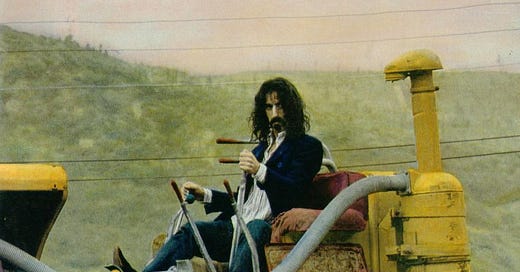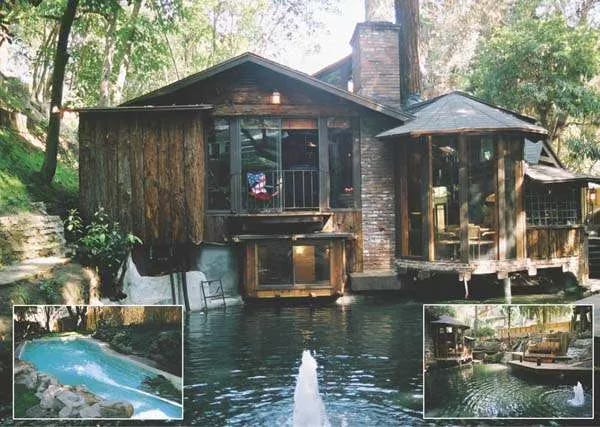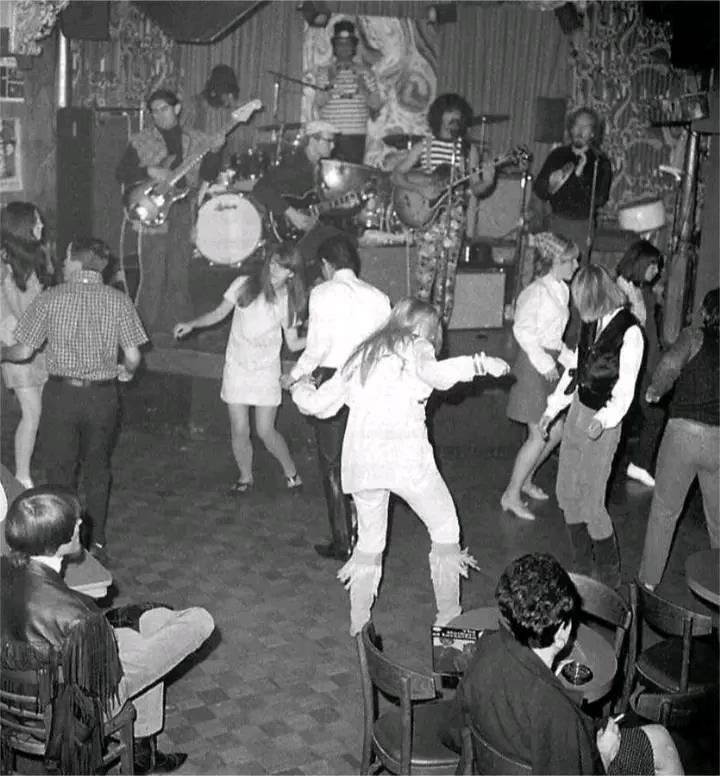The Rock and Roll Treehouse
Alice Cooper, Eric Burdon, John Mayall and others remember Frank Zappa's cabin in Laurel Canyon
Frank Zappa and tractor, Laurel Canyon
As of this week the Los Angeles fires now appear to be nearly contained, and I noticed that one of the neighborhoods which escaped the flames was Laurel Canyon, a tranquil lush area with a ton of important countercultural history. Over the decades, the list of former residents has been a roll call of L.A. rock music, from Joni Mitchell to Linda Ronstadt, Brian Wilson, Alice Cooper, Gram Parsons, Carole King, Jackson Browne, James Taylor, JD Souther, Bonnie Raitt, Jim Morrison, and Harry Nilsson, and members of Buffalo Springfield, the Byrds, the Eagles, the Monkees, and the Mamas & the Papas. So much, from just one canyon—including Frank Zappa and his legendary Log Cabin residence.
In 2003 I was driving through the canyon and spotted a FOR SALE sign at 2401 Laurel Canyon Boulevard. I ended up talking to the owner, who operated a fleet of rock tour buses, and was also the manager of Bill Ward, drummer for Black Sabbath. Why he needed his own manager is anyone’s guess, and I’m sure it’s probably a long story. Anyway, the owner explained the history of the property, and especially the Frank Zappa era, and added that this was the first time it was on the market in 30 years. I got a tour, and saw that the primary log cabin structure had burned down years before, but a treehouse still remained, decorated in Zappa memorabilia. The grounds were also noteworthy, with sculpted paths and rock walls, and little cubbyholes built into the hillside. I was told that these features were built by Hollywood set designers, moonlighting on their off hours. Very much a hippie party vibe. The owner had bought this property, poured some money into it, and was now trying to flip it to someone who would appreciate the notoriety. I pitched the idea to a magazine, and was able to speak with a bunch of rock stars, and they graciously shared their memories of Zappa’s cabin. But don’t bother paying a visit. In 2017, the land was purchased by the Citizens for Los Angeles Wildlife and turned over to the Mountains Recreation & Conservation Authority for land management and permanent preservation. A version of the story below first appeared in Mojo magazine in 2003. Please add your comments below, would love to hear any Laurel Canyon stories!
If you’re in the Bay Area, or near a computer, I’ll be doing a few readings of new material next month:
Feb 8, 12 noon PST - online here, to celebrate launch of Lauren Parker’s new book Dark Way Down, with Tomas Moniz, Meg Elison, Noah Sanders and more.
Feb 23, 2-4pm PST - Spec’s bar, North Beach in S.F., with Kim Addonizio, Alan Black, Mary Ladd, Frances Stroh, and Matthew Zapruder.
According to one website, this is what the cabin looked like.
It’s 1968, at the Laurel Canyon Country Store in the Hollywood hills. Drummer Ansley Dunbar meets a 15-year-old hippie chick named Pattie, and asks if she wants to go to a party at Frank Zappa’s house. They pull into a driveway of an old log cabin. People are wandering in and out of an enormous 80-foot living room. In the basement, musicians take turns bowling on a Day-Glo painted bowling alley. The adjoining guest house sports a duck pond and two trees growing out of the living room. Couples are huddled in artificial caves built into the hillside. Someone tells her the cabin was once the house of movie cowboy Tom Mix, and that Harry Houdini used to live across the street. Pattie looks around at the outrageously dressed girls, taking care of a baby named Moon Unit, and the cute young guys playing guitars, and realizes she’s inside the epicenter of the Laurel Canyon music scene.
“Mick Jagger was there,” she now recalls. “A couple guys from the Animals. Mark Lindsay from Paul Revere and the Raiders. Alice Cooper. Janis Joplin. Roger McGuinn and Mike Clarke from the Byrds. Brian MacLain and Arthur Lee, who were in Love. Another band in L.A. called the Seeds. Andy Summers. Sam Andrew was there, from Big Brother. John Mayall. Mick Taylor—he was the only one my age.”
Pattie O’Neal pauses to think back. “The Cowsills, the prototype wholesome family? One or two of the older Cowsill guys were there,” she says. “They were really stoned, they looked terrible!”
In the late ’60s, this house was the premier stop of Los Angeles rock and roll. After 35 years, the log cabin is long gone, but amazingly, the treehouse is newly renovated and on the real estate market. For a cool $2.4 million someone can own a slightly fuzzy slice of history.
As a caretaker gives me a tour, pointing out such erroneous information as the spot where gunfighter Wyatt Earp supposedly died, I am reminded that in Hollywood, in certain neighborhoods, it isn’t unusual for an address to have a rich lineage. Every third house seems to be once owned by somebody with screen credits, even if it was only the second unit director on Land of the Pharoahs. The Canyon is singular in this regard. Since the 1920s, the nouveau riche have scurried up into the hills to hide, from Bugsy Siegel to W.C. Fields, Robert Mitchum, Robert Heinlein, Harry Houdini, and current celebrities like Julian Lennon and Julianne Moore. It’s quiet, woodsy, and less than a mile from Sunset Boulevard.
Tom Mix cabin on the left, Harry Houdini house across the street on the right.
But 2401 Laurel Canyon Boulevard in particular has retained an unusual fondness. According to Tom Mix historian Boyd Magers, the log cabin was constructed back in 1915, as a masculine retreat for wealthy men to escape their women and smoke and drink in peace. Its highlight was an 80-foot living room, with floor-to-ceiling stone fireplace. Tom Mix, a fun-loving movie cowboy, lived here briefly, and for a time cashed Hollywood’s biggest checks. After Mix moved to Beverly Hills, the cabin was rented for several decades.
As the 1960s washed over Los Angeles, the ripple of fuck-you new money began seeping into the canyon, young people with record contracts and reefer smirks. When architect Robert Byrd needed a place to live between marriages, his son Gary helped him build a small house just behind the Tom Mix log cabin, which was then vacant. Gary Byrd recalls when clearing the property, the father and son discovered “one of the Barrymore kids” living inside a shack. The following year, a communal family of weirdos moved into the cabin and treehouse, centered around two underground hipsters named Vito Paluekas and Carl Franzoni, organizers of freeform dance troupes at clubs along Sunset Strip. The dancers wore freaky clothing, and flopped and pogoed alongside bands like the Byrds and the Mothers of Invention.
The Mothers of Invention and dancers, Whisky a Go Go, 1966
One night a young Pamela Des Barres followed the so-called “Zappa dancers” to a party at the Log Cabin. In those days, Carl Franzoni was known as Captain Fuck.
“He wanted to fuck everybody,” remembers Des Barres, now the elder spokeswoman of rock groupies. “He had this long tongue, and wore a cape with a big “F” on the back. He was standing in the doorway, with big pink curlers clamped in his pubic hair.”
“We had dances there,” says Carl Franzoni, who is still chasing young girls in northern California. “We had lots of rehearsals.” He adds slyly, “It was a fuck scene, too.”
In 1967 the Zappa dancers split their rent with staff from the hippie publication The Oracle. Retired journalist John Bilby recalls at least 36 people living and partying at the Log Cabin and treehouse, including the band Fraternity of Man.
“Tim Leary was definitely there, George Harrison and Ravi Shankar were there,” Bilby says. “The psychedelics that were being taken. They were fucking right out there on the grounds, a thousand miles from civilization.”
In the spring of 1968, The Oracle moved out, and Frank Zappa moved in, fresh from an extended gig in New York. His bizarre, satirical synthesis of Spike Jones and Edgar Varese, combined with a guitar virtuosity and serious business acumen, attracted a parade of curious visitors, from Paul Butterfield to Eric Clapton and Jimi Hendrix. Among Zappa’s many projects was producing the GTOs, a band made up of groupies hanging around the cabin.
“We were sitting in the living room,” remembers Des Barres. “I remember Frank telling us, ‘You should be a band. How would you girls like to be in a band?’ He sat us down in the basement. We made lists of the rock stars we wanted to meet, and wrote the album down there.”
One house guest was John Mayall, who had just broken up the Bluesbreakers and was taking in the Los Angeles scene. The strange-looking GTO girls made a lasting impression.
“Obviously flamboyant comes to mind,” Mayall chuckles. “Quite a shock to see for a person visiting from England.”
Mayall recovered sufficiently to record songs both about Zappa’s cabin and the rigors of venereal disease.
Between guests, Zappa held auditions for his Bizarre and Straight record labels. One band from Phoenix, Alice Cooper, had been turned down by every record company and was going nowhere in a hurry. Fortunately, Cooper was dating Zappa’s babysitter, and so Zappa agreed to hear Cooper’s band, at the cabin at 7 o’clock.
“We were so excited we got there at seven in the morning,” says Cooper. “We set up in the living room and started playing our set. Frank came down the stairs with a cup of coffee, and he goes, ‘What the hell are you doing?’ You said seven. ‘Seven at NIGHT.’ So he listened to about four songs and he’s, ‘Okay okay, you’re signed, I’ll sign you.’”
A young guitarist named Bill Harkleroad, aka Zoot Horn Rollo, showed up to audition for Captain Beefheart, and saw members of the Stones, the Who, the Mothers, studio musicians and about 25 others all wandering about.
“Within a few minutes I’m in a jam session with Frank, Don Vliet, Mick Jagger, Art Tripp,” remembers Harkleroad. “Frank and Don were my rock world heroes.” He was so nervous he could only play a few notes.
Alice Cooper recalls another Jagger visit, when the Stone showed up inebriated with girlfriend Marianne Faithfull, and the straight-edge Zappa kicked them both out of the house.
“I was sitting there, just a kid hanging out to record,” says Cooper. “And I went, ‘Frank Zappa just threw Mick Jagger out of his house—because he’s drunk.’ To me, that’s so far in another universe that I couldn’t even believe it.”
One of Zappa’s canyon neighbors was vocalist Eric Burdon, whose first memory of the house concerns borrowing a motorcycle from Jimmy Carl Black, drummer of the Mothers of Invention. Black threw in a bonus: a few lines of speed.
“I was so stoned,” Burdon says, “that I was heading north on Pacific Coast Highway before I remembered you have to put gas in the machine, and I ran out of gas and was stranded. I spent the night on the beach, freezing cold. I got back and saw Jimmy, and he said, “Good stuff?”
The word was out: Laurel Canyon was where it was at. Groovy scenes blossomed at the homes of Joni Mitchell, the Byrds, the Monkees, Mama Cass. And the Log Cabin stood out, clearly visible out the car window to tourists. “It was omnipresent,” says record executive and former Mothers drummer Denny Bruce. “If you lived in the valley and came into Hollywood, you’re coming over Laurel Canyon, so every jerk from the valley—‘Heyyy mannn, there’s Frank Zappa’s pad.’”
Tired of the attention, the Zappas moved out after just six months. Log Cabin parties continued with new tenants. But the canyon was experiencing a seismic shift in music and drugs du jour. Along with ‘70s blue-jean millionaires like Fleetwood Mac and the Eagles came an underbelly of junkies and squatters. The Cabin and treehouse scene grew creepy.
“They were kind of rave parties,” recalls DJ Rodney Bingenheimer. “Weird black lights, stuff like that. People were stoned and out of it.”
The darkness coalesced on Halloween morning 1981, when the Log Cabin mysteriously caught fire. Some said it started from a banjo player’s cigarette, other claimed it was a drug lab explosion. As helicopters hovered over the blaze, police roped off the property and a crowd watched it burn to the ground. Only the treehouse was saved. Some, like Pamela Des Barres, poked through the rubble. Others, like Alice Cooper, simply drove past, not wanting to think about it.
When music producer Bob Crosby rented the property in 1984, he discovered drums and drumsticks stuffed into the cabin’s fireplace chimney, which was still standing.
“Down in the basement, one of the walls had signatures from the Stones, Eric Burdon and the Animals, John Sebastian and the Loving Spoonful,” he says.
Hundreds of people still dropped by each Halloween, expecting a raging party. Crosby said no parties, and raised his family. But he did rent out the grounds for video shoots by Rickie Lee Jones and Stone Temple Pilots.
In 1999 the property was purchased by Mike Slarve, owner of a fleet of rock tour buses, and manager of Black Sabbath drummer Bill Ward. Slarve has spent the past three years renovating the treehouse and grounds, and has seen dozens of characters wandering over to tell their stories. Between Captain Fuck, Harry Houdini, and the Manson Family, Slarve has heard just about everything. “You don’t know if they’re completely insane or they’re telling the truth,” he says. “It kind of lights up everybody’s imagination.”
Pattie O’Neal now lives a block from the treehouse, and drives by each day on her way home. “It’s so bizarre,” she says. “I don’t think a day goes by that I don’t turn there and think about it. It was the house that changed me from the cheerleader to the hippie.”










Great piece Jack! I've lived in Laurel Canyon for 25 years and relished every piece of hippie history you uncovered! Great quotes. Will forward to Moon.
Early 70’s we were in college and lived at 8333 lookout mountain drive. There was a bust of Bela Lugosi and remnants of Joni Mitchell living there. I think we were the only non-celebrities on the street.